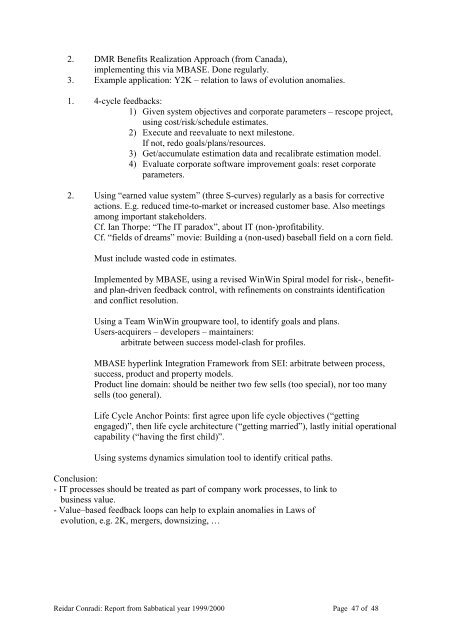( )¤0¤ 2 13$% 2 2 465¤5 57 §¤£¦9 8( A - Department of Computer ...
( )¤0¤ 2 13$% 2 2 465¤5 57 §¤£¦9 8( A - Department of Computer ...
( )¤0¤ 2 13$% 2 2 465¤5 57 §¤£¦9 8( A - Department of Computer ...
Create successful ePaper yourself
Turn your PDF publications into a flip-book with our unique Google optimized e-Paper software.
2. DMR Benefits Realization Approach (from Canada),<br />
implementing this via MBASE. Done regularly.<br />
3. Example application: Y2K – relation to laws <strong>of</strong> evolution anomalies.<br />
1. 4-cycle feedbacks:<br />
1) Given system objectives and corporate parameters – rescope project,<br />
using cost/risk/schedule estimates.<br />
2) Execute and reevaluate to next milestone.<br />
If not, redo goals/plans/resources.<br />
3) Get/accumulate estimation data and recalibrate estimation model.<br />
4) Evaluate corporate s<strong>of</strong>tware improvement goals: reset corporate<br />
parameters.<br />
2. Using “earned value system” (three S-curves) regularly as a basis for corrective<br />
actions. E.g. reduced time-to-market or increased customer base. Also meetings<br />
among important stakeholders.<br />
Cf. Ian Thorpe: “The IT paradox”, about IT (non-)pr<strong>of</strong>itability.<br />
Cf. “fields <strong>of</strong> dreams” movie: Building a (non-used) baseball field on a corn field.<br />
Must include wasted code in estimates.<br />
Implemented by MBASE, using a revised WinWin Spiral model for risk-, benefitand<br />
plan-driven feedback control, with refinements on constraints identification<br />
and conflict resolution.<br />
Using a Team WinWin groupware tool, to identify goals and plans.<br />
Users-acquirers – developers – maintainers:<br />
arbitrate between success model-clash for pr<strong>of</strong>iles.<br />
MBASE hyperlink Integration Framework from SEI: arbitrate between process,<br />
success, product and property models.<br />
Product line domain: should be neither two few sells (too special), nor too many<br />
sells (too general).<br />
Life Cycle Anchor Points: first agree upon life cycle objectives (“getting<br />
engaged)”, then life cycle architecture (“getting married”), lastly initial operational<br />
capability (“having the first child)”.<br />
Using systems dynamics simulation tool to identify critical paths.<br />
Conclusion:<br />
- IT processes should be treated as part <strong>of</strong> company work processes, to link to<br />
business value.<br />
- Value–based feedback loops can help to explain anomalies in Laws <strong>of</strong><br />
evolution, e.g. 2K, mergers, downsizing, …<br />
Reidar Conradi: Report from Sabbatical year 1999/2000 Page 47 <strong>of</strong> 48
















